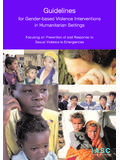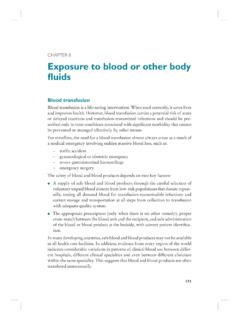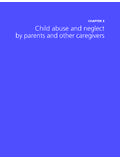Transcription of RECLAIMING POWER AND PLACE - mmiwg-ffada.ca
1 RECLAIMING . POWER . AND PLACE . EXECUTIVE. SUMMARY. OF THE. FINAL REPORT. N AT I O N A L I N Q U I R Y I N T O M I S S I N G. AND MURDERED INDIGENOUS. women AND GIRLS. Cette publication est galement disponible en fran ais : R clamer notre pouvoir et notre PLACE : Sommaire du rapport final de l'Enqu te nationale sur les femmes et les filles autochtones disparues et assassin es CP32-163/2-3-2019E-PDF. ISBN: 978-0-660-30951-4. COVER IMAGE: Special thanks to the artists whose work appears on the cover of this report: Dee-Jay Monika Rumbolt (Snowbird), for Motherly Love The Saa-Ust Centre, for the star blanket community art piece Christi Belcourt, for This Painting is a Mirror TA B L E O F C O N T E N T S. Introduction to the Executive Summary of the Final Report: Understanding violence Against Indigenous women , Girls, and 2 SLGBTQQIA People 1.
2 Defining Genocide 2. The Truth-Gathering Process of the National Inquiry 5. Overview of the Final Report 7. Successes and Challenges of the National Inquiry 8. Section 1: Establishing a New Framework 9. Chapter 1: Centring Relationships to End violence 10. Chapter 2: Indigenous Recognitions of POWER and PLACE 13. Chapter 3: Emphasizing Accountability through Human Rights Tools 15. Chapter 4: Colonization as Gendered Oppression 17. Section 2: Encountering Oppression 21. Chapter 5: Confronting Oppression Right to Culture 23. Chapter 6: Confronting Oppression Right to Health 27. Chapter 7: Confronting Oppression Right to Security 32. Chapter 8: Confronting Oppression Right to Justice 36. Section 3: Healing Families, Communities, and Nations 43.
3 Chapter 9: Wellness and Healing 44. Chapter 10: I am here for justice, and I am here for change : Commemoration and Calling Forth 46. Chapter 11: Valuing Lived and Front-Line Experiences 49. Notes 52. Calls for Justice 53. i Executive Summary of the Final Report INTRODUCTION. Introduction to the Final Report: Understanding violence Against Indigenous women , Girls, and 2 SLGBTQQIA People F. irst Nations, Inuit, and M tis women , girls, and 2 SLGBTQQIA. eople in Canada have been the targets of violence for far too long. This truth is undeniable. The fact that this National Inquiry is happening now doesn't mean that Indigenous Peoples waited this long to speak up; it means it took this long for Canada to listen. More than 2,380 people participated in the National Inquiry into Missing and Murdered Indigenous women and Girls, some in more ways than one.
4 Four hundred and sixty-eight family members and survivors of violence shared their experiences and recommendations at 15 Community Hearings. Over 270 family members and survivors shared their stories with us in 147 private, or in-camera, sessions. Almost 750 people shared through statement gathering, and 819 people created artistic expressions to become part of the National Inquiry's Legacy Archive. Another 84. Expert Witnesses, Elders, and Knowledge Keepers, front-line workers, and officials provided testimony in nine Institutional and Expert and Knowledge Keeper Hearings. The truths shared in these National Inquiry hearings tell the story or, more accurately, thousands of stories of acts of genocide against First Nations, Inuit and M tis women , girls, and 2 SLGBTQQIA people.
5 This violence amounts to a race-based genocide of Indigenous Peoples, including First Nations, Inuit, and M tis, which especially targets women , 1. Executive Summary of the Final Report INTRODUCTION. girls, and 2 SLGBTQQIA people. This genocide has been empowered by colonial structures, evidenced notably by the Indian Act, the Sixties Scoop, residential schools, and breaches of human and Inuit, M tis and First Nations rights, leading directly to the current increased rates of violence , death, and suicide in Indigenous populations. Defining Genocide The term genocide was first used by Polish-Jewish legal scholar Raphael Lemkin in the lead up to the Second World War. Lemkin's definition of genocide included an important principle, which didn't restrict the definition to physical destruction of a nation or ethnic group.
6 As he explained: Generally speaking, genocide does not necessarily mean the immediate destruction of a nation, except when accomplished by mass killings of all members of a nation. It is intended rather to signify a coordinated plan of different actions aiming at the destruction of essential foundations of the life of national groups, with the aim of annihilating the groups The objectives of a plan of genocide would include actions aimed at the disintegration of the political and social institutions, of culture, language, national feelings, religion, and the economic existence of national groups, and the destruction of the personal security, liberty, health, dignity, and even the lives of the individuals belonging to such groups.
7 2. A legal definition of genocide wasn't incorporated into international law until 1948, following the programs of mass murder carried out by the Nazis during the Second World War. In its articulation in this forum, though, it became more restrictive. Drafters argued over whether the definition of genocide should be universal, as in other criminal categories, or restricted to certain groups, as well as whether leaving some groups out might actually serve to target them. Lemkin, who participated in the drafting, argued that social and political groups shouldn't be included, because they didn't have the permanence of non-political groups. States in the negotiations among them the Soviet Union, Poland, Great Britain, and South Africa.
8 Worried that enforcement of such a convention could violate the principles of state sovereignty. In the end, the convention was a compromise: an agreement among states and the result of difficult negotiations. Disagreements remain today over what does or does not constitute genocide, including as it relates to Canada. However, as Canadian writer and filmmaker Larry Krotz explains, applying the term genocide to what happened in North America has a decades-long history, including in the 1973 book The Genocide Machine in Canada: The Pacification of the North, by Robert Davis and Mark Zannis; and 1993's American Holocaust: Columbus and the Conquest of the New World, by David E. Stannard. A more recent work, Accounting for Genocide: Canada's Bureaucratic Assault on Aboriginal People, by Dean Neu and Richard Therrien, was published in 2003.
9 2. Executive Summary of the Final Report INTRODUCTION. In recent years, and in light of the work of the Truth and Reconciliation Commission of Canada's (TRC) Final Report, many Indigenous thinkers have turned to evaluating how the term genocide applies in Canada. As genocide scholar Andrew Woolford has noted, Canadian scholars have not given colonial genocide in Canada enough attention, due in part, perhaps, to the fact that the spatial and temporal boundaries of the case of genocide in Canada are not obvious. As he notes, If Canadian settler colonialism was genocidal, where exactly did it occur and when did it begin? And considering the intergenerational effects at stake, as well as the perpetuation of settler colonial practices, can we say for sure whether genocide has even ended?
10 3 Usually, and as he notes, Much nuance is lost by force fitting it into a traditional comparative genocide studies paradigm that defines cases on national rather than regional or international levels of analysis. 4. Officially, the Government of Canada currently recognizes five genocides: the Holocaust, the Holodomor genocide, the Armenian genocide in 1915, the Rwandan genocide of 1994, and the ethnic cleansing in Bosnia from 1992 to 1995. As Krotz maintains, In our world, genocide is absolutely the worst thing you can say about an action undertaken by individuals or groups. So atrocious, in fact, that many historic events that carry the characteristics of genocide struggle to or fail to get named as such. 5 But as Woolford argues, and as the testimonies heard by the National Inquiry make clear, we must consider the application of genocide in both legalistic and in social terms, and as it persists today.







